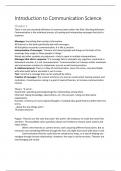Introduction to Communication Science
Chapter 1
There is not one standard definition of communication within the field. Working definition:
Communication is the relational process of creating and interpreting messages that elicit a
response.
Messages: Everything that contains information.
All theories in the book specifically deal with messages.
All disciplines encounter communication, it is like a junction.
Interpretation of messages: “Humans act toward people and things on the basis of the
meanings they assign to those people or things.”
Words and other symbols are polysemic—they’re open to multiple interpretations.
Messages that elicit a response: ‘if a message fails to stimulate any cognitive, emotional or
behavioral reaction, it is not communication.’ Communication isn’t always verbal: emotional
and unconscious reactions to statements are just as well communication.
A relational process: There is a flow of communication, never the same, only describable
with what went before and what is yet to come.
Text: record of a message that can be analyzed by others.
Creation of messages: The content and form of a text are constructed: textual analysis and
motivation. Consciousness-raising is a goal of several theories, to increase communication
choices.
Theory: “A set of…
Systematic: specifying (and explaining) the relationships among them.
Informed: taking knowledge, observations, etc. into account, ruling out alternative
explanations
Hunches: A theory isn’t one inspired thought or isolated idea; good theories define their key
terms.
…about the way things work.”
→ predict theories
Popper: Theories are like nets that catch ‘the world’. We endeavor to make the mesh finer
and finer. This possibility raises questions about out freedom to choose some actions and
reject others.
Others view theories as camera lenses, each acquiring different focal points. But as
everyone sees something different through the lens, we might lose touch with what is real.
Communication theories could also be compared to maps, as a way of helping you
navigate through human relationships. However, the map is not the territory. Theories are
everchanging and varied.
, Chapter 2
Behavioral scientist: A scholar who applies the scientific method to describe, predict and
explain recurring forms of human behavior. Conducts experiments.
Rhetorician: A scholar who studies the ways in which symbolic forms can be used to identify
with people, or to persuade them toward a certain point of view. Interprets texts.
Objective approach: The assumption that truth is singular and is accessible through
unbiased sensory observation; committed to uncovering cause-and-effect relationships.
Interpretive approach: The linguistic work of assigning meaning or value to communicative
texts; assumes that multiple meaning or truths are possible.
Humanistic scholarship: Study of what it’s like to be another person in a specific time and
place; assumes there are few important panhuman similarities.
Scientists stress the forces that shape human behavior: interpretive scholars focus on
conscious choices made by individuals. Human choice is problematic for the behavioral
scientist because as individual freedom goes up, predictability of behavior goes down.
Conversely, the roots of humanism (interpretive) are threatened by a highly restricted view
of human choice.
Effectiveness is concerned with successfully communicating information,
ideas, and meaning to others. It also includes persuasion.
Participation is concerned with increasing the possibility that all points of
view will affect collective decisions and individuals being open to new
ideas. It also encourages difference, opposition, and independence.
Objective theorists usually foreground effectiveness, interpretive theorists focus on
participation.
Social scientists like to remain objective and need objective empirical evidence.
Critical interpreters believe there is no safe harbor in which researchers can avoid the
power structure; they value social relevance.
Metatheory: Theory about theory; the stated or inherent assumptions made when creating
a theory.





